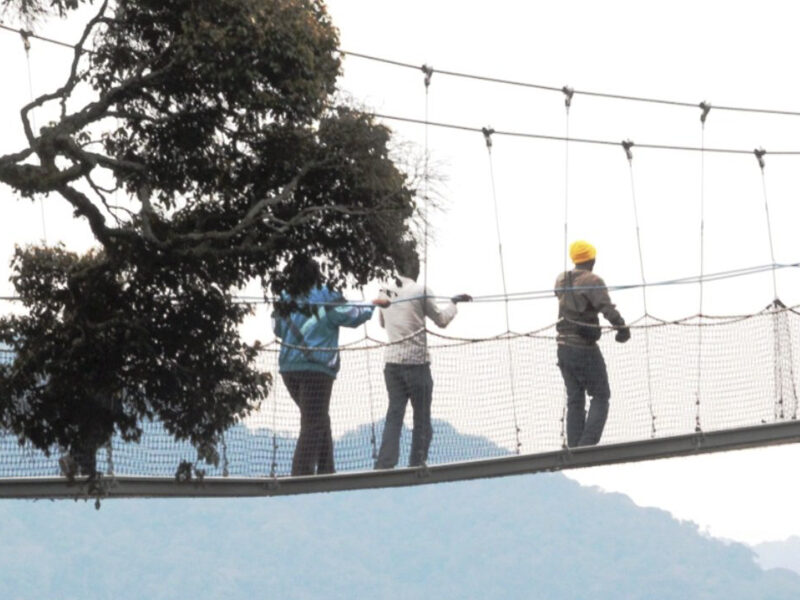Day 1: Arrival
Arrival at Entebbe International Airport. Meet your local guide and transfer to Lake Victoria Windsor Hotel. (Birders who arrive in the early hours of the day will have a welcome birding afternoon around Entebbe Botanical Gardens). Look out for Slender-billed Weaver, Brown-throated Weaver¸ Golden-backed Weaver, Yellow-backed Weaver, Grey-headed Gull, Long-tailed Cormorant, Common Squacco Heron,Yellow-billed Duck, Pied Kingfisher, Giant Kingfisher, Swamp Flycatcher, Broad-billed Roller, Black-and-white Casqued Hornbill, Splendid Glossy Starling, Black-headed Gonolek, Orange Weaver, Verreaux’s Eagle-owl, Red-chested Sunbird, Ross’s Turaco, Pied Hornbill, Crowned Hornbill, Open-billed Stork, Great Reed Warbler, Sedge Warbler, Grey-capped Warbler and many others.
Day 2: Birding in Entebbe
Early morning birding the Lincoln Trail. The local bird guides established this trail early in 2000. Over 170 species have been recorded. Serious birders may record 110 birds in a single day. The local guides now recommend this trail as the best birding site near to Kampala and Entebbe. Look out for White-headed Barbet, Red-headed Lovebird, Double-toothed Barbet, Brown Twinspot, Tambourine Dove, Black-headed Bush-shrike, Scaly Francolin, Tropical Boubou and many others.
Day 3: Mabamba Swamp
After an early breakfast, drive to Mabamba Swamp 50km west of Kampala. Stop enroute in Mpigi Swamp for papyrus rarities. Open your eyes for a White-winged Warbler, Papyrus Gonolek, Yellow-backed Weaver, Northern Brown-throated Weaver, Blue-headed Coucal and other swamp specialities. Continue on to Mabamba Swamp. Most of the birding is done on a canoe. We will keep a look out for Shoebill both in the sky and down on the marsh. Also look out for Swamp Flycatcher, Purple Swamphen, African Water Rail, Common Moorhen, Lesser Jacana, African Jacana, African Pygmy-goose, White-faced Whistling-duck, Squacco Heron, Blue-breasted Bee-eater, Winding Cisticola, Goliath Heron and Black Crake to mention but a few. Return to your hotel for dinner and overnight stay.
Day 4: Queen Elizabeth National Park
Depart early in the morning for Queen Elizabeth National Park (QENP) birding en-route. Stop at Mbarara for lunch. QENP has over 600 recorded bird species. Serious birders may be interested to know that the one-day record for QENP is 296; one of the highest in the whole World. An excellent variety seen here includes pelicans, skimmers, kingfishers, thick-knees, storks, martins, swallows, weavers, raptors, canaries, kites, and many grassland specialties. Birding in the park begins early in the morning on the open savannah. We return to the hotel for lunch. In the afternoon enjoy birding the Kazinga Channel on the boat. This channel joins Lake Edward and Lake George. The highlight on this boat trip is African Skimmer. Return to the Buffalo Safari Lodge for Dinner and overnight stay.
Day 5: Queen Elizabeth National Park
Depart early in the morning for Queen Elizabeth National Park (QENP) birding en-route. Stop at Mbarara for lunch. QENP has over 600 recorded bird species. Serious birders may be interested to know that the one-day record for QENP is 296; one of the highest in the whole World. An excellent variety seen here includes pelicans, skimmers, kingfishers, thick-knees, storks, martins, swallows, weavers, raptors, canaries, kites, and many grassland specialties. Birding in the park begins early in the morning on the open savannah. We return to the hotel for lunch. In the afternoon enjoy birding the Kazinga Channel on the boat. This channel joins Lake Edward and Lake George. The highlight on this boat trip is African Skimmer. Return to the Buffalo Safari Lodge for Dinner and overnight stay.
Day 6: Bwindi Impenetrable National Park
After an early breakfast, birding around the hotel is productive. Check out at 10:00am for Bwindi Impenetrable National Park. Enjoy your picnic lunch as you bird en-route. When you arrive in Bwindi you will be given a typically enthusiastic African welcome. Enjoy your dinner in the noiseless jungle close to the home of those marvellous forest giants: the gorillas. You won’t miss the early morning songs of the Snowy-capped Robin-chat and the Grey-capped Warbler. Listen to the Luehder’s Bush-shrike as you enjoy your breakfast. On a lucky day, the Grey-green Bush-shrike, Black Bee-eater and Narina’s Trogon will be see around the accommodation.
Day 7: Bwindi Impenetrable National Park
Birders have described the birdwatching here as some of the best birding in the world! Birding begins early in the morning around the luxury bush camp. After breakfast we carry a picnic lunch for a whole days birding in the only natural tropical forest in the area. This forest has over 300 species of bird recorded.
These include Red-throated Alethe, Equatorial Akalat, Forest Robin, Montane Oriole, Grey-throated Barbet, Hairy-breasted Barbet, African Broadbill, Black Bee-eater, Pale-breasted Illadopsis, Narina’s Trogon, Pettit’s Cuckoo-shrike, Shelley’s Greenbul, Ansorge’s Greenbul, White-bellied Robin-chat, Black-faced Rufous-warbler, Kivu Ground-thrush, Short-tailed Warbler, Red-fronted Antpecker, Oriole Finch and many other forest rarities. This forest receives rainfall almost throughout the year. A rain jacket and hiking shoes will check this. Return for dinner and overnight at the camp.
Day 8: Bwindi Impenetrable National Park
Optional day for gorilla trekking. Most birders who have been to this forest have shown interest in trekking these cousins of human beings in their native jungle homes. Carry your picnic lunch and enjoy the forest giants.
Day 9: Bwindi Impenetrable National Park
Depart at the crack of dawn for a 50km drive to the highest peak of the forest Ruhiija. Several checks en-route at good birding sites may produce rare species such as White-starred Robin, Grey Cuckoo-shrike, Strange Weaver, Banded Prinia, Brown-chested Alethe, Slender-billed Greenbul, Yellow-streaked Greenbul, White-browed Crombec, Mountain Illadopsis, Luehder’s Bush-shrike, Grey-green Bush-shrike; all these and many others are among the 345 species recorded in this park. Birding on the way to and at the Mubwindi Swamp is very productive. One has to be prepared to walk on steep mountain tracks with the chance of seeing African Green Broadbill. You drop in altitude from about 2400m to 2050m above sea level. Birding in the bamboo zone is good for the Handsome Francolin, Archer’s Robin-chat, Stripe-breasted Tit, Purple-breasted Sunbird, Mountain Greenbul, Grauer’s Warbler, Rwenzori Batis, Waller’s Chestnut-winged Starling, Dusky Crimsonwing, Mountain Illadopsis, Mountain Yellow Warbler to mention a just a few. Birders who come with camping equipment can camp at Ruhiija campground. Also seen here are L’hoest’s Monkey, Guereza Colobus, Blue Monkey and several duikers.
Day 10: Bwindi Impenetrable National Park
Depart at the crack of dawn for a 50km drive to the highest peak of the forest Ruhiija. Several checks en-route at good birding sites may produce rare species such as White-starred Robin, Grey Cuckoo-shrike, Strange Weaver, Banded Prinia, Brown-chested Alethe, Slender-billed Greenbul, Yellow-streaked Greenbul, White-browed Crombec, Mountain Illadopsis, Luehder’s Bush-shrike, Grey-green Bush-shrike; all these and many others are among the 345 species recorded in this park. Birding on the way to and at the Mubwindi Swamp is very productive. One has to be prepared to walk on steep mountain tracks with the chance of seeing African Green Broadbill. You drop in altitude from about 2400m to 2050m above sea level. Birding in the bamboo zone is good for the Handsome Francolin, Archer’s Robin-chat, Stripe-breasted Tit, Purple-breasted Sunbird, Mountain Greenbul, Grauer’s Warbler, Rwenzori Batis, Waller’s Chestnut-winged Starling, Dusky Crimsonwing, Mountain Illadopsis, Mountain Yellow Warbler to mention a just a few. Birders who come with camping equipment can camp at Ruhiija campground. Also seen here are L’hoest’s Monkey, Guereza Colobus, Blue Monkey and several duikers.
Day 11: Bwindi Impenetrable National Park
Depart at the crack of dawn for a 50km drive to the highest peak of the forest Ruhiija. Several checks en-route at good birding sites may produce rare species such as White-starred Robin, Grey Cuckoo-shrike, Strange Weaver, Banded Prinia, Brown-chested Alethe, Slender-billed Greenbul, Yellow-streaked Greenbul, White-browed Crombec, Mountain Illadopsis, Luehder’s Bush-shrike, Grey-green Bush-shrike; all these and many others are among the 345 species recorded in this park. Birding on the way to and at the Mubwindi Swamp is very productive. One has to be prepared to walk on steep mountain tracks with the chance of seeing African Green Broadbill. You drop in altitude from about 2400m to 2050m above sea level. Birding in the bamboo zone is good for the Handsome Francolin, Archer’s Robin-chat, Stripe-breasted Tit, Purple-breasted Sunbird, Mountain Greenbul, Grauer’s Warbler, Rwenzori Batis, Waller’s Chestnut-winged Starling, Dusky Crimsonwing, Mountain Illadopsis, Mountain Yellow Warbler to mention a just a few. Birders who come with camping equipment can camp at Ruhiija campground. Also seen here are L’hoest’s Monkey, Guereza Colobus, Blue Monkey and several duikers.
Day 12: Lake Mburo National Park
From here you will travel eastwards through the terraced mountains of Kigezi to the open plains and rocky hillsides of Ankole. Your drive is punctuated with several stops to see Bare-faced Go-away-bird, Wattled Lapwing, Southern Red Bishop, Variable Sunbird, African Harrier, hawks, larks, and many others. Enjoy the fabulous Long-horned Ankole cattle as you bird.
Dinner and overnight in the park with its excellent views in Lake Mburo National Park. Enjoy the songs of Morning Dove, Dideric Cuckoo, Grey-capped Warbler, Black-headed Weaver and Ring-necked Dove.
Day 13: Lake Mburo National Park
Leave at dawn to see African Finfoot at Lake Mburo before it disappears into the papyrus beds floating on the lake. Look out for Brown-chested Lapwing, Lilac-breasted Roller, Black-bellied Bustard, Helmeted Guineafowl, Coqui Francolin, Rufous-napped Lark plus many raptors. Of course this is the only park with Eland, Burchell’s Zebra and Impala in the whole of this region. Return for lunch at the camp. Rest in the afternoon for transfer to the airport next day. (Evening birding can be arranged for nightjars).
Day 14: To Kampala
After a morning game drive proceed to Kampala. Lunch at Masaka. Stop at the equator for the monument, Mpambire drum makers, and at Kampala for shopping if required.
Day 15: Departure
Transfer to the airport for departure









